Final report for FNE15-827
Project Information
Robariah Farms, a New England farm specializing in sustainable agricultural practices through the production of local, pasture-raised, kosher-certified meat, conducted a multi-year project to determine the processing efficiency and cost-effectiveness of commercial kosher poultry processing using local, small-scale, state-certified, non-kosher facilities that were outfitted to support traditional kosher processing, in comparison with the use of large-scale, industrial, kosher-certified, USDA poultry processing facilities.
To conduct the analysis, two types of commercial poultry processing facilities were used:
- Local, small-scale, non-kosher, state-certified poultry processing facility, which was customized to support traditional kosher processing. This facility, which typically processes between 150 to 250 chickens per day, required the following key modifications to support the processing of a kosher-certified commercial meat product (as further discussed in this report):
- The purchase and use of specialized kosher processing equipment, including a commercial grade dry plucker
- The hiring of specialty personnel trained and experienced in traditional kosher processing
- The application of traditional kosher processing techniques to produce a kosher-certified product.
- Large-scale, industrial, kosher-certified, USDA-inspected poultry processing facilities. These facilities are designed to exclusively support traditional kosher-certified poultry processing. They typically process between 3,000 to 15,000 chickens per day.
The project resulted in a determination that higher processing efficiency and cost-effectiveness is currently achieved using large-scale, industrial, kosher-certified, USDA-inspected poultry processing facilities. Using the local, small-scale facility was about 5 times less efficient in processing and cost about 30% more per chicken as conducting kosher processing using a large-scale, industrial, kosher-certified, USDA-inspected poultry processing facility.
Project results were presented at regional conferences and local community forums that focus on key stakeholders of sustainable agriculture, including meat producers, processors, and consumers. A final case report is also being circulated to local sustainable farming organizations—UMass Extension Center for Agriculture, New England Small Farm Institute, Northeast Organic Farming Association, and Hazon—for distribution in their respective news and research publications.
Introduction:
Background of the Problem
“Limited access to slaughter and processing facilities, especially those with Federal or State inspection, continues to be challenging for farmers seeking to satisfy consumer demand for local meat and poultry products….Farmers may have to drive several hours or longer to the closest inspected processor or one with the desired certifications, skills, or services” (“Solving Processing Issues a Key to Successful Local Meat Marketing,” Economic Research Service, USDA, December 2013).
In Massachusetts and New England, the absence of local kosher poultry processors is a significant problem with market demand rising for sustainably raised, locally produced kosher meat. The problem is compounded by the question of cost effectiveness that small-scale commercial producers face in accessing local kosher processing. Without local kosher processing opportunities, growers are limited in their ability to meet market demand for a local, kosher product. As a result, consumers are limited to a narrower poultry marketplace consisting of either locally produced but not kosher meat, or kosher meat that is not locally or sustainably produced.
In Massachusetts and New England, the absence of local kosher poultry processors is a significant problem with market demand rising for sustainably raised, locally produced kosher meat.
To respond to growing market demand for local, sustainable, kosher poultry, small-scale commercial growers may choose to transport their locally raised poultry to a non-local kosher processor. The extent of transport, however, undermines the key economic, environmental, and social benefits of providing a locally produced, sustainably grown product. As a result, negative impacts to the sustainability of the product, business, and community include the following:
- Increased health/safety risk and higher stress levels among chickens prior to slaughter
- Increased carbon emissions and environmental pollutants from travel
- Increased processing costs from truck, trailer, and gas expenses
- Increased costs associated with meeting processors’ local, state, or federal regulatory requirements
- Diversion of financial resources from local rural communities to large-scale food systems
- Substantial operational planning to accommodate small-scale production volumes at a large-scale processing facility
The significance of the problem is evidenced by the demand to produce and purchase local sustainable meat and kosher products. A report from Community Involved in Sustaining Agriculture (“Demand and Options for Local Meat Processing [in the CT River Valley]” June 2008), found that there is “significant demand for slaughter and processing services, and potential supply of inputs for slaughter/processing services. 59% of the farmers who responded said they would more than double their herds with additional processing capacity….Location is the major factor for farmers deciding where to bring their animals for slaughter.”
In seeking a local kosher product, the problem of high demand and low supply is exasperated. According to a 2009 Mintel market research report, 44% of the kosher market is Jewish consumers. In Massachusetts and New England, 4–5% of the population is Jewish—almost double the national percentage. While 15% of those who purchase kosher products do so for religious reasons, most who seek out kosher products buy the items for food quality (62%), healthfulness (51%), and food safety (34%). 19% of the kosher market is Muslim who consume food certified as Halal.
About the Project Lead
Robariah Farms produces local, pasture-raised, kosher meat and is the project lead of this SARE project. Robariah Farms raises chickens, turkeys, and ducks for commercial meat sales through a direct-to-customer Community Supported Agriculture (CSA) program, as well as wholesale to food co-ops, restaurants, conference centers, and summer camps. Approximately 10 acres of open pasture land are leased from two nearby local farms in the Pioneer Valley of Western Massachusetts. Approximately two to five acres are used as a pasture for every 1,000 chickens raised, based on varying growth rates of different poultry breeds and seasonal or ground conditions.
The key business challenge facing Robariah Farms is balancing small-scale production of pasture-raised poultry with the high costs and operational challenges of kosher processing. However, these challenges represent an important opportunity to meet a growing market demannd for locally grown, pasture-raised, ethically processed, kosher meat.
About the Technical Advisor
The technical advisor for this project was Peter Laznicka, a state-licensed poultry slaughterer who owns Valley Poultry, LLC. Throughout this project, Mr. Laznicka operated a local processing unit owned by New England Small Farm Institute (NESFI), a nonprofit founded in 1978 whose mission is to promote small farm development by providing information and training for aspiring, beginning and transitioning farmers.
About the Project Partners
A number of consultants and partners were initially identified to support Robariah Farms with this project. In the course of implementing multiple approaches to kosher processing, additional parties were involved. Following is a summary of key partners (also listed in the Cooperators section of this report).

- Rabbi Mayer Abramowitz, lead shochet (ritual slaughter) of New England Kosher, a regional kosher certification agency. Rabbi Abramowitz was hired to oversee the multiple sessions of kosher processing in accordance with Jewish law, which were conducted at local, small-scale commercial processing facilities.
- Rabbi Yosef Gottlieb, lead mashgiach (supervisor) from the UMass-Amherst Chabad. Rabbi Gottlieb was hired to supervise the kashrut (“making kosher”) of the multiple sessions of local kosher processing in support of Rabbi Abramowitz.
- Valley Poultry, LLC., owned by Peter Laznicka (project technical advisor), a state-licensed poultry slaughterer who operated the local mobile processing unit owned by New England Small Farm Institute (NESFI) in Western Massachusetts. Operations of local kosher processing of chickens for this project was managed by Valley Poultry.
- New England Small Farm Institute (NESFI), owner of a local, state-certified mobile poultry processing unit operated by the technical advisor. Local kosher processing of chickens for the project was conducted on the NESFI unit, which can typically process approximately 150-250 chickens per day (or about 30 chickens per hour with a crew of three people) using conventional, non-kosher methods.
- Two large-scale, industrial, kosher-certified, USDA-inspected kosher poultry processing facilities located in the Northeastern US. Two different facilities were employed during the course of this project for comparison purposes. These facilities are located in northeast U.S. states and typically process between 2,000 and 15,000 chickens on average per day.
- UMass Extension Center for Agriculture initially agreed to serve as a communication partner for this project. The final publication of this project report will be shared with local sustainable farming organizations—UMass Extension Center for Agriculture, New England Small Farm Institute, Northeast Organic Farming Association, and Hazon—for publication in their newsletters.
The key project objective was to explore the commercial viabilitiy of kosher poultry processing using a local, small-scale, state-certified, non-kosher processing facilitity that was customized for kosher processing. Comparative analysis of the processing efficiency and cost-effectiveness was conducted on eight separately processed batches of chickens across a two-year period. Batches varied in their respective volumes and breeds. Each batch was processed at either a local, small-scale, state-certified, non-kosher poultry processing facility (customized for kosher processing) or at a large-scale, industrial, kosher-certified, USDA poultry processing facility located in the Northeastern US.
To use the local, small-scale, state-certified, non-kosher facility, a number of research-based modifications were required to support traditional kosher processing practices that led to a kosher-certified commercial meat product. Funding from the SARE grant directly supported essential modifications to the processing equipment, the personnel involved, and the practices applied throughout processing. Following is a summary of those modifications.
Modifications for Kosher Processing
- Kosher processing for commerical products requires the on-site supervision of an established kosher certification agency. The agency certifies that each product is kosher by marking or stamping the packaging label at the end of the process. For this research project, a kosher certification agency was hired (a different one than we originally identified due to scheduling conflicts). The agency included a shochet (trained ritual slaughterer) and mashgiach (supervisor) to oversee kosher processing and ensure that kosher practices and techniques were comprehensively applied, as further discussed below. (Refer to Endnotes of this section for a summary from Temple Grandin of kosher slaughter rules required by Jewish law that "improve welfare during slaughter and reduce the animal's reaction."1)
- The shochet conducted the kill using specific techniques and a specialized knife to minimize animal pain.
- The use of specialized dry-plucking equipment (i.e., not wet plucking) to remove feathers was required. In kosher poultry processing, scalding the bird in hot water to loosen pinfeathers (a common practice in conventional non-kosher processing) is prohibited due to the risk of cooking the meat before it has been fully drained and cleaned.
- Evisceration was supervised by the shochet to ensure proper internal organ inspections were conducted.
- Kashering of the carcasses was conducted, a process to remove excess blood from the meat by soaking the carcass in water for 30 minutes after evisceration, then salting it for 60 minutes, and triple-rinsing it in clean water before packaging.
Data points were consistently collected during the kosher processing of each successive batch to analyze the processing efficiency and cost effectiveness (data and images are provided in the "Research" section of this report).
Endnotes:
1 Kosher processing consists of five rules that are required for a correct cut. Temple Grandin, a world-renowned consultant to the livestock industry on animal behavior and processing, has observed that if the rules are disobeyed the animal will struggle. If these rules are obeyed the animal has little reaction. The five rules are (Code of Jewish Law Y.D. 23) as follows: 1) 'Shehiyah' (Delay) - A pause of hesitation during the incision of even a moment makes the animal's flesh unkosher. The knife must move in an uninterrupted sweep. 2) 'Derasah' (Pressing) - The knife must be drawn across the throat by forward/backward movements, not by hacking or pressing. 3) 'Haladah' (Digging) - The knife must be drawn over the throat so that it is visible while the incision is being performed. It must not be stabbed into the neck or buried by fur, hide, or feathers in the case of a bird. 4) 'Hagramah' (Slipping) - The limits within which the knife may be applied are from the large ring in the windpipe to the top of the upper lobe of the lung when it is inflated, and corresponding to the length of the pharynx. 5) 'Ikkur' (Tearing) - If either the esophagus or the trachea is torn during the incision the carcass is rendered unkosher. Tearing can occur if there is a nick in the chalaf (special knife used only for kosher slaughter). The shochet also has to check the blade before and after each animal is slaughtered to make sure it is perfectly smooth and has no nicks. A nick will cause pain. If the blade is not perfect it is forbidden to use it. It must be re-honed or replaced. The transection must be examined by the shochet immediately after the incision to ascertain that is was done according to the requirements. (Source: http://www.grandin.com/ritual/rules.shechita.proper.cut.html)
Cooperators
Research
Kosher Processing in Multiple Batches at Multiple Facilities
To achieve project goals, several batches of chickens were processed to provide ample data for analysis and to reflect small-scale, commercial production volumes. Because the project's research methods had not been tried to date, processing efficiencies were assumed to increase in the progression of batches. As a result, the volumes of chickens processed per batch incrementally increased. The number of batches and volume per batch were identified in consultation with the project's technical advisor and cooperating kosher supervision agency, based upon their experience and expertise in poultry processing.
In total, 1,700 chickens were raised for processing in eight separate batches at three different facilities over a two-year period (as shown in the table that follows):
- Batches #1-6 - These six smallest batches by volume were processed at a local, small-scale, state-certified, non-kosher poultry processing facility, which was customized for kosher processing.
- Batches #7-8 - These two largest batches by volume were processed at two different large-scale, industrial, kosher-certified, USDA-inspected poultry processing facilities.
In addition, the chickens consisted of two different breeds, which were processed at different facilities to analyze the potential impact to processing efficiencies based on certain breed qualities (such as weight, thickness of feathering, and feather coloration):
- Cornish Cross - a standard, fast growing, white-colored meat bird known for rapid growth and weight gains
- Freedom Rangers - a slower growing, multi-colored feathered chicken derived from an American and European heritage breed (Source: Freedom Ranger Hatchery)
| KOSHER PROCESSING: SUMMARY OF BATCHES | ||||||
| Batch | Facility | Volume Goal | Volume Actual | Volume Kosher | Breed | Processing Date |
| 1 | Small-scale, local | 50 | 20 | 18 | Cornish Cross | 7/6/15 |
| 2 | Small-scale, local | 50 | 61 | 60 | Cornish Cross | 7/7/15 |
| 3 | Small-scale, local | 100 | 84 | 82 | Cornish Cross | 7/19/15 |
| 4 | Small-scale, local | 100 | 91 | 88 | Cornish Cross | 7/20/15 |
| 5 | Small-scale, local | 150 | 130 | 130 | Cornish Cross (50%), Freedom Rangers (50%) |
8/18/15 |
| 6 | Small-scale, local | 150 | 149 | 145 | Cornish Cross (50%), Freedom Rangers (50%) |
8/19/15 |
| 7 | Large-scale, industrial | 600 | N/A | N/A | Cornish Cross | 10/1/15 |
| 8 | Large-scale, industrial | 500 | N/A | N/A | Freedom Rangers | 6/1/16 |
Data Points of Kosher Processing
Quantifiable Data. Data were collected for each batch and analyzed collectively across batches to analyze processsing efficiencies and cost-effectiveness. Quantifiable data included batch volumes, overall processing time and processing time by key phase, input of human labor, and costs. To analyze processing efficiency, measurements were collected during key phases:
- Slaughter, plucking, and evisceration
- Soaking, salting, rinsing
- Packaging
For the two batches processed at different large-scale, industrial, kosher-certified facilities, overall processing time and costs were identified. Information pertaining to input of human labor and processing time by key phase at the industrial facilities was not made available.
Contextual Data. Contextual data were also identified to support the measured data. For example, processing configurations were modified between batches to support increased processing efficiencies (e.g., different dry pluckers were used; wet plucking was attempted after cold soaking the birds; different conditions were created to accomodate the birds during the salting phase based on weather conditions). More information on contextual data is provided in the "Results and discussion" section of this report.
Modifications for Kosher Processing
As previously discussed in the Project Objectives section of this report, to use the local, small-scale, state-certified, non-kosher facility, a number of research-based modifications were required to support traditional kosher processing. Following is a summary of those modifications:
- Kosher processing requires the on-site supervision of an established kosher certification agency. The agency certifies that each product is kosher by marking or stamping the packaging label at the end of the process. For this research project, a kosher certification agency (New England Kosher) was hired (a different one than we originally identified due to scheduling conflicts). The agency included a shochet (trained ritual slaughterer) and mashgiach (supervisor) to oversee kosher processing and ensure that kosher practices and techniques were comprehensively applied. The following images display to final product label with official processing and kosher supervision information. Each label was hand-stamped by the kosher agency to certify the product as kosher.
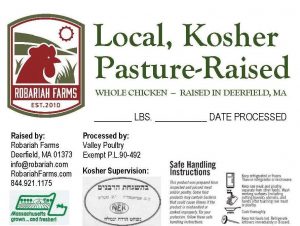
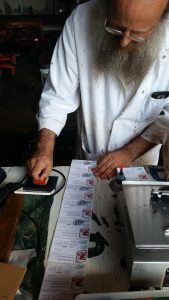
- The shochet conducted the kill using specific techniques and a specialized knife to minimize animal pain.

- The use of specialized dry-plucking equipment (i.e., not wet plucking) to remove feathers was required. In kosher poultry processing, scalding the bird in hot water to loosen pinfeathers (a common practice in conventional non-kosher processing) is prohibited due to the risk of cooking the meat before it has been fully drained and cleaned. (See discussion and images in the following "Results and discussion" section of this report.)
- Evisceration was supervised by the shochet to ensure proper internal organ inspections were conducted.
- Kashering of the carcasses was conducted, a process to remove excess blood from the meat by soaking the carcass in water for 30 minutes after evisceration, then salting it for 60 minutes, and triple-rinsing it in clean water before packaging.
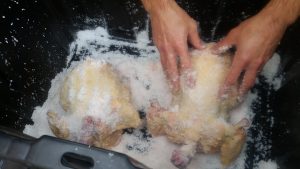
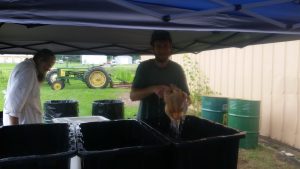
Equipment and Personnel. For a summary of the standard equipment, kosher-specific equipment, and personnel that were used to conduct kosher processing using the local, small-scale, state-certified facility, refer to this downloadable list: Equipment and Personnel: Summary List for Kosher Processing
Through this work a complete set of data has been collected to analyze the processing efficiency and cost-effectiveness of commercial kosher poultry processing using a local, small-scale, state-certified, non-kosher facility that was outfitted to support traditional kosher processing. Data sets were compared to poultry processing using a) the same local, small-scale facility for non-kosher processing, and b) large-scale, industrial, kosher-certified, USDA poultry processing facilities. Data results of the project's research are provided in this comprehensive, downloadable table: Data Results of Kosher Poultry Processing by Robariah Farms
Analysis of the project research indicates the following results about the processing efficiency and cost-effectiveness of commercial kosher poultry processing using a local, small-scale, state-certified, non-kosher facility that was outfitted to support traditional kosher processing.
As compared to non-kosher processing using the same facility:
- Processing efficiency is less than half (about 45%).
- Cost per chicken is nearly 3 times more.
As compared to using a large-scale, industrial, kosher-certified, USDA-inspected poultry processing facility:
- Processing efficiency is about 5 times less.
- Cost per chicken is about 30% more.
Discussion Notes:
- Kosher Certification Agency. Cost-effectiveness is negatively impacted by the requirement to hire a kosher certification agency to conduct the kosher slaughter and oversee kosher processing to produce a commercial kosher product. It was a flat fee for this service, resulting in an increase in cost-effectiveness as the processing batch volume increased.
- Dry Plucking. A key challenge in kosher poulty processing using the local, small-scale, state-certified, non-kosher facility was the dry plucking. In kosher poultry processing, scalding the bird in hot water to loosen pinfeathers (a common practice in conventional non-kosher processing) is prohibited due to the risk of cooking the meat before it has been fully drained and cleaned. Large-scale, industrial, kosher-certified poultry processing facilities use highly mechanized plucking technology.
- Comparative analysis: Plucking proved to be the major process bottleneck in conducting this research. While scalding and wet plucking can remove over 95% of a chicken's feathers in 2-3 minutes during conventional, small-scale, non-kosher processing, dry plucking methods used for this project typically removed 80-95% of a chicken's feathers in 4-5 mintues. As a result, increased human labor to hand-pluck the final 5 to 20% of feathers (especially on the wings) was required during the project's processings.
For this project, the following four different dry plucking methods were piloted:
-
- A heavy duty machine with a four-inch square window where replaceable discs rotated quickly to strip feathers. This machine proved costly ($4000+), dangerous (discs were hard and would easily injure you if touched), and ineffective in its plucking.
- Two Fowl Plucker machines proved safe (rubber fingers are soft to touch when spinning), cost-effective ($745 each), and reliable, though plucking took about 4 minutes per bird.
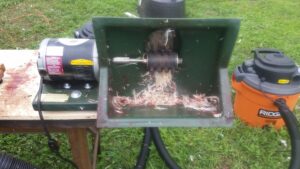
Fowl Plucker - Standard rotating tub/drum with water sprayer and interior rubber fingers. This proved convenient because it is used during non-kosher plucking, efficient in terms of being able to do 2-3 birds simultaneously without a person holding them; however it required at least some pre-soaking in cold water and the end result was at best a 75% plucked chicken, requiring increased human labor to complete the plucking.
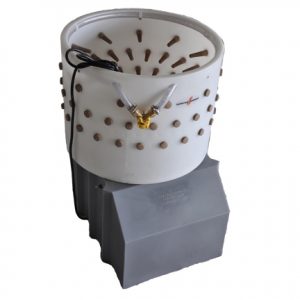
Standard wet-plucking machine - Ashley Manual Plucker Model #15 (21 inch) (see sample image below) proved most effective in terms of removing most feathers in least amount of time (about 95% of feathers in 4 min per bird), relatively safe (if you touched the rotating fingers it would hurt, but not injure you) and affordable (approximately $3000 new or $500 used) given its merits.
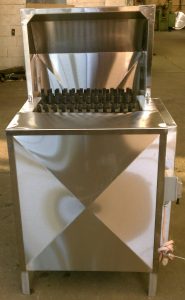
Note: Large-scale, industrial, kosher-certified poultry processing facilities use highly mechanized plucking technology as birds proceed on an overhead conveyer line, as shown in this image:
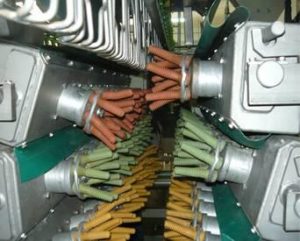 .
.
- Soaking, Salting, and Rinsing. This kosher-specific processing phase adds at least 90 minutes of processing time (30 minutes for soaking and 60 minutes for salting) as compared to non-kosher processing.
- Increased human labor. As previously discussed, increased human labor was required to primarily support the plucking process. Dry plucking chickens removed 80-95% of feathers in 4-5 minutes. However, to support a commercial grade, high quality meat product, the remaining feathers had to be removed by hand-plucking. This process added up to 5 minutes of plucking time.
- Outdoor conditions. For this project, the local, small-scale, state-certified, non-kosher facility (that was outfitted to support traditional kosher processing) was an open-air, outdoor, mobile poultry processing unit. Processing in the summer months meant that the outside heat was a variable requiring different tactics to minimize the heat's impact. This challange was exascerbated in conducting kosher processing due to the extra time required for soaking, salting, and rinsing phase. Different tactical methods were attempted during that phase: installing shade structures; using high-powered oscillatinng fans; using deep-chest freezers; and using nearby indoor shelters.
- Educating Participating Parties. Use of the local, small-scale, state-certified, non-kosher facility to support traditional kosher processing required convening and educating a number of different agricultural, commercial, and consumer parties. Education across parties was required to ensure that parties could provide the appropriate expertise and input. The kosher supervision agency had to understand the state regulations governing the state-certified poultry processing facility; the technical advisor who managed the facility had to understand the kosher rules and requirements; crew members and volunteers had to understand and apply all rules. The result was the involvement of a large quantity of parties, representing diffferent interests, who collaborated and innovated to achieve a locally produced, locally processed commercial meat product.
- Bringing small-scale volumes to large-scale facilities. There are challenges in using large-scale industrial processing facilities to accomodate small-scale volumes. For example, industrial facilities used for this project can process up to 15,000 chickens per day and operate at this level most days of the year. Their focus on processing efficiency across large volumes provides for less flexibility and product attention when accommodating a smaller batch of chickens (e.g., 600 chickens). There is minimal attention paid or adjustments made by the facilities to effectively process different breeds or different size birds, which is typical in small-scale poultry production.
The results of this project provide a more clear indication about the commercial viability of kosher poultry processing using a local, small-scale, state-certified, non-kosher processing facility that was customized for kosher processing. By applying different approaches to the key modifications of the local facility, as well as processing at multiple large-scale industrial kosher facilities for comparative purposes, the project revealed the presence of key processing and cost challenges in making the process economically viable. These challenges, however, were incrementally reduced during the course of the project research as equipment quality and personnel experience were improved.
The ongoing importance of this project is embedded in the increasing market demand for local, sustainable, high quality products, including meat. Local, pasture-raised, kosher meat represents these key consumer values. The ability to raise meat locally and process it locally is integral in providing consumers with a truly local, sustainable product. In addition, local processing provides the same level of transparency to consumers as local production of the animals. Consumers have the opportunity to directly engage in the meat processing operation or meet with the involved parties to understand how the process meets their consumer quality standards. This level of transparency is not afforded when meat processing occurs in distant, unseen, industrial facilities.
Recommendations for further research and development would focus on using additional high-volume dry plucking equipment in a local facility that can support larger volumes. By continuing to increase processing efficiency and cost-effectiveness of local kosher processing, to a threshold that is competitve with using large-scale industrial kosher facilities, a commercially viable product is possible.
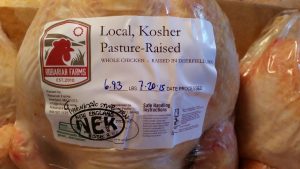
Education & Outreach Activities and Participation Summary
Participation Summary:
- The project included six days of educational processing that included the open participation of volunteers who were eager to learn and partcipate in local kosher processing. Each day included a brief educational session to discuss the processing conditions being applied.
- Data analyses and project results are being shared with UMass Extension Center for Agriculture for circulation through the UMass Crops, Dairy, Livestock, Equine, and Poultry Newsletter that reaches over 5600 recipients, along with the MA 4-H Newsletter.
- The final project report will be published on the Project Lead's commerical website.
- The Project Lead presented at a course on sustainable food systems at Greenfield Community College.
- A seminar and presentation was given by the Project Lead at a course at Mount Holyoke college.
- A presentation was given by the Project Lead for PVGrows, a collaborative network dedicated to enhancing the ecological and economic sustainability and vitality of the Pioneer Valley food system.
- A presentation was given by the Project Lead at Congregation B'nai Israel in Northampton to discuss the intersection of business and cultural values.
- The Project Lead was a panelist at the Hazon Food Conference, which convenes hundreds of local producers and consumers to explore the complexities of the global food system and connect to ancient food traditions.
- Multiple onsite farm tours have been conducted by the Project Lead for different educational groups to explore first-hand the production of local, pasture-raised, kosher meat production.
- The final project report will be shared with several key organization for potential distribution, including Community Involved in Sustaining Agriculture (CISA), Northeast Organic Farming Association (NOFA), New England Small Farm Institute, and Hazon.
Learning Outcomes
Kosher processing using local, small-scale facilities
Project Outcomes
Positive feedback has been received from customers, local food advocates, and sustainable food producers across New England. This positive feedback reinforces the need to build on the results of this project's research to create a commercially viable meat product that is truly local, sustainably produced, and kosher processed. Feedback further reinforces the goals and values of the Project Lead's Robariah Farms, which seeks to provide costumers with the opportunity to directly engage with the sustainable production practices used to raise its animals and the high quality, ethical practices applied in the kosher processing of the meat. This level of transparency is important to the mission of the farm and its target customers.
Testimonials and Press
-
“Our customers say they are delicious! Including one customer that bought 15, and she may well buy some more from the ones remaining. I had a couple myself and they are exceptional.” - Alex Khitrik, Owner of Inna’s Kitchen
-
"It's so rare that we truly know where our meat comes from and how it was raised. But with the chickens we got from Robariah Farms there was nothing we didn't know. And they tasted great! It's really been a terrific experience that we plan on repeating next year." -- Sam K. Weber, Customer
-
“Your chickens are the best I've had! I mean, it's hard to eat other chicken after I've had yours. I certainly don't like to buy any other chickens, just the ones from your farm.” -- Rachel Barbanel-Fried, Psy.D., Customer
-
"It's the best I ever had!" - Batshua bat Yehonatan, Customer
- "I have been roasting the chickens we get from Robariah Farms. They are very delicious, tender, and my 5 year old daughter loves the taste!" - Andrea Newman, Customer
-
Kosher Jews needn’t be ‘chicken’ about this menu, The Jewish Advocate, 5/23/2014
The project's research methods were successful due to the careful planning, communication, collaboration, and research that was conducted by appropriate parties before and during project implementation. Appropriate volumes were processed and adjusted as the research progressed, allowing for more accurate and robust data to be collected. Cost-effectiveness and processing efficiencies were realized and quantified, as initially anticipated. As a result of the methods and results, the project's key objectives were met. The question of whether it is commercially viable to conduct kosher poultry processing using a local, small-scale, non-kosher, state-certified facility was answered. While that answer is currently "no," the project's results yielded critical information and positive trends that suggests that answer can change with further research.
Key challenges included the volatility of processing outdoors for a process that due to kosher rules require extended processing times. Recommendations for further research and development would focus on using additional high-volume dry plucking equipment in a local indoor facility that can support larger volumes. By continuing to increase processing efficiency and cost-effectiveness of local kosher processing, to a threshold that is competitive with using large-scale industrial kosher facilities, a commercially viable product is possible.
Knowledge of this project's results will most benefit customers, food advocates, and meat producers in New England and worldwide who are invested in locally sourced, sustainably raised, high quality meat products. Meat producers, kosher supervision agencies, and meat processors will directly benefit from the lessons and data of this project in working collaboratively to find innovative solutions to meet the market demand for affordable, locally produced, and locally processed pasture-raised kosher meat.